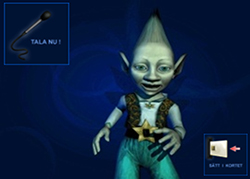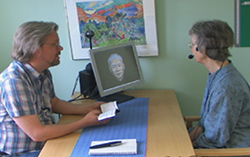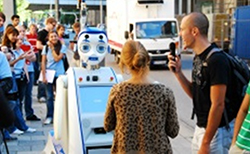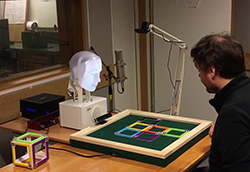Past projects
|
92-95 |
The Waxholm project was initiated in 1992 as a research effort for building spoken dialogue systems. In this project, new dialogue management and parsing modules were developed and combined with TMH’s existing speech synthesis and recognition. |
|
|
96 |
A System for Teaching Spoken Dialogue Systems Technology. The aim of this work was to put a fully functioning spoken dialogue system into the hands of the students as an instructional aid. |
|
|
98-99 |
August was a animated conversational agent called August, whose persona was inspired by August Strindberg, the famous Swedish 19th century author. The August project was initiated as a way to promote speech technology and KTH in connection with Stockholm being the Cultural Capital of Europe in 1998. The system was available for the general public at the Culture Center in Stockholm, daily from August 1998 to March 1999. |
|
|
99-02 |
The AdApt project had as its goal to be the foundation for the development and evaluation of advanced multimodala spoken dialogue systems. Within the project, a spoken dialogue system was developed in which a user could cooperate with an animated talking agent to solve more complex problems than what had previously been achieved in our systems. | |
 |
02-03
|
In the TänkOm project, visitors at the telecom museum could enter an apartment of the future and interact with the animated agent Pixie. The syste was available to the public for more than two years, resulting in a large corpus of human-computer interactions. |
 |
02-05 |
The EU funded project NICE, had the goal of this project was to build a speech enabled computer game where children could interact with animated 3D game characters. |
 |
06-09 |
The overall objective of MonAMI is to mainstream accessibility in consumer goods and services, including public services, through applied research and development, using advanced technologies to ensure equal access, independent living and participation for all in the Information Society. |
 |
10-12 |
The purpose of the IURO project is to explore how robots can be endowed with capabilities for extracting missing information from humans through spoken interaction. The test scenario for the project is to build a robot that can autonomously navigate in a real urban environment and enquire human passers-by for route directions |
|
10-13 |
The projects investigate how a robot can improve its visual scene understanding by engaging in spoken dialogue with a human. The goal of the project is to build a research platform which combines spoken dialogue technology with visual object recognition in a robot. |
|
 |
11-14 |
The aim of the proposed project is to develop a system for safe information access and communication while driving. The aim of the proposed project is to develop a system for safe information access (search, navigation, point of interest) and communication (texting) while driving. |
 |
16-18 |
Our main goal is to create robots that analyze and track human behavior over time in the context of their surroundings (situational) using audio-visual monitoring in order to establish common ground and mind-reading capabilities. On BabyRobot we focus on the typically developing and autistic spectrum children user population. |